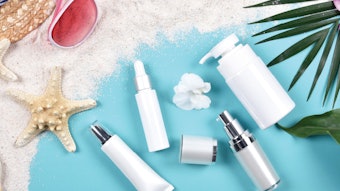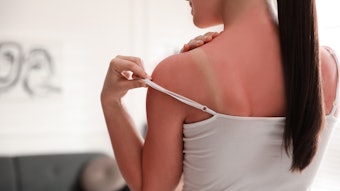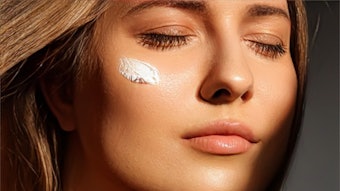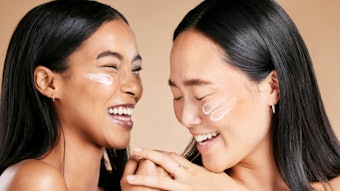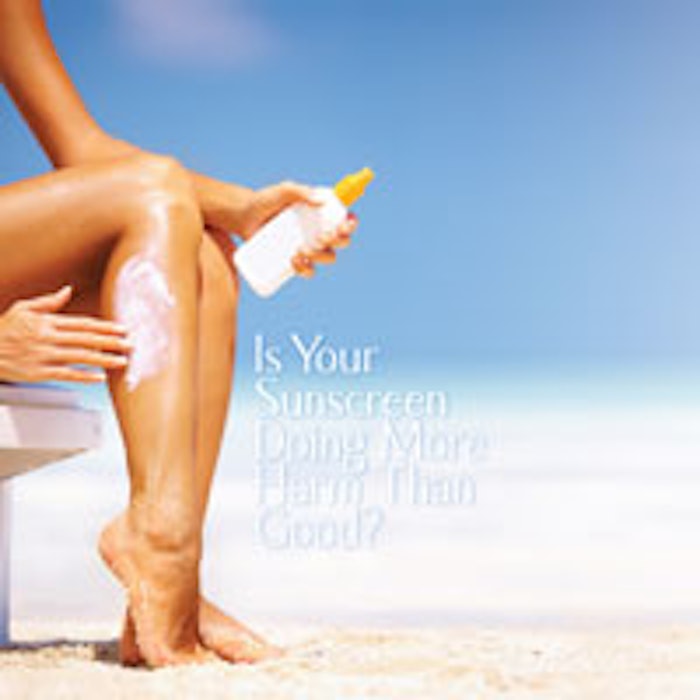
There’s no question about it—UV protection is absolutely essential. UV rays are responsible for a large majority of photoaging and are the leading cause of cancer—skin cancer—in the United States; however, with changes in sunscreen regulations constantly coming down the pipeline, it’s important to educate clients on proper skin protection.1, 2
There is a lot of misinformation circulating about various sunscreen ingredients—mineral vs. chemical—and what constitutes adequate protection. How do you know that what your clients are using will protect them from harmful UV damage and at the same time keep their skin healthy? Is it possible that some chemicals used to protect skin from damage may indeed contribute to other skin issues? Some reports have stated that certain chemical additives in sun care products actually proliferate the development of malignant cells due to their free radical-generating properties.3
Consumers need to know about the dangers of chemical-blockers, as well as the natural sunscreen alternatives that are available, such as zinc oxide. A sunscreen that contains unhealthy doses and combinations of chemicals may fundamentally limit its function—protecting the skin. What are these synthetic ingredients and why are they used? What are the alternatives, and why should skin care professionals educate clients about this?
The sun and skin
Some sun is important not only for the skin, but for a person’s overall well-being. Exposure to sunlight has an energizing effect and is good for the soul. Sunlight is also a source of vitamin D—D3 to be specific. Vitamin D3 is produced in the skin after exposure to UVB rays and defends the body against microbial invaders,4 and regulates the concentration of calcium and phosphate in the bloodstream to promote strong, healthy bones. It also aids in the absorption of other vitamins.
Ten minutes in the sun each day can be highly beneficial, but remind clients about the photoaging damage UV rays cause, including wrinkles, brown spots and slack skin, to name a few. Make sure clients protect their faces and vulnerable sun-damaged areas with good physical ingredients, such as zinc and titanium dioxide. These also guard against other environmental toxins.5, 6
Chemicals and sunscreen
Today, the vast majority of SPF formulas have a laundry list of chemicals that potentially subject the skin to dangerous ingredients. Some of the most common chemical ingredients in nonmineral sunscreens include octinoxate, oxybenzone (a form of benzophenone) and avobenzone.
In addition to increased cancer rates, these unstable chemicals have also been linked to hormone imbalance, dysfunctions in sexual development and function, as well as birth defects because of their estrogenlike effects.7
- Octinoxate (octyl methoxycinnamate)—an estrogenic chemical that has been linked to hormonal imbalance and increased rates of cancer.8
- Oxybenzone (a derivative of benzophenone)—a chemical that may cause hormone disruption.9, 10 In Europe, products with 0.5% or more of this chemical must have the warning label “Contains oxybenzone.”11
- Avobenzone—a free radical-generator that absorbs UV radiation energy and, since it cannot destroy it, converts the light energy to chemical energy, which is typically released as free radicals in the body.12–14
When several of these chemicals are combined to form a broad-spectrum sunscreen, the formula may release its own free radicals, subjecting the skin to damage.13, 14
Below the surface
Scientists have also been researching the ability of these chemicals to permeate the skin and enter the blood stream, possibly resulting in other damaging effects. Each of these chemicals—oxybenzone, octinoxate and avobenzone—work as penetration-enhancers, meaning they are easily absorbed by the skin, so the longer they sit on the skin, the higher of a threat they pose.15
A study conducted in the United States using biomonitoring detected oxybenzone (or benzophenone-3) in 96% of the population.7, 16 In Europe, a study found traces of four common sunscreen chemicals in breast milk, potentially exposing infants to these chemicals.17
Physical vs. chemical
Topical sunscreens are broadly classified into two groups: chemical-absorbers and physical-blockers. Chemical-absorbers absorb UV rays while physical blockers reflect UV rays.5 There has long been much debate over chemical vs. physical blockers, primarily between skin care professionals and product manufacturers. In working with and seeking advice from various labs about sunscreen formulas, it’s been my experience that chemical-based formulas are typically cheaper and easier to produce, which may be why they are so widely available to the consumer. However, many chemical-absorbers provide less-than-adequate UV protection on their own and must be combined with other chemicals to do so. More importantly, research has shown that many of these ingredients do not protect against UVA rays, the highly dangerous rays that have the ability to penetrate the deeper layers of the skin and pose an even greater threat. This has been linked to increased melanoma rates, as well as the proliferation of photoaging by degrading collagen and elastin.12–14
SPF levels refer to UVB ray protection, but now the U.S. Food and Drug Administration (FDA) is requiring sunscreens to indicate on their labels whether they protect against UVA rays, as well. The new UVA/UVB protection labels will read “broad-spectrum SPF” and only those of SPF 15 and higher can claim to reduce the risk of skin cancer and photodamage. However, recommend that clients opt for at least an SPF of 30 because it provides 97% protection from UV damage.
Physical blockers have been shown to be more effective in protecting against both UVA and UVB rays.18 Titanium dioxide and zinc oxide are the two most commonly used blockers. These naturally occurring ingredients protect against the full UV spectrum; however, one of the major issues with naturally occurring blockers is the chalky cosmetic appearance and texture that is often associated with them.
Zinc oxide is an inorganic compound and an essential mineral for the body. It plays an important role in cell production, promotes healthy skin and hair, boosts the immune system and also provides broad-spectrum protection, which, in turn, helps reduce UVA-induced free radical production in the deeper layers of the skin. Zinc oxide is not absorbed by the skin; rather it sits on the skin’s surface, blocking both UVA and UVB rays.19
Titanium dioxide is derived from titanium and is a highly reflective chalky mineral. It is nonirritating, nonallergenic and noncomedogenic, which means it doesn’t cause or aggravate acne. The physical blocker is commonly used in sunscreens because it offers both UVA and UVB protection. Titanium is found in nature in minerals such as rutile, anatase and brookite.5, 20
The skin care professional’s role
What is your role and how do you provide optimum healthy sun protection for your clients? Educate clients about the importance of sun protection, and provide them with the tools to obtain and maintain healthy skin. You want peace of mind when it comes to what you recommend for your clients’ skin. There are other factors that play into how well a sunscreen formula performs, depending on the type of work you are doing and what your clients are using in their daily skin care regimens. If clients are on vitamin A derivatives, other acid-based correctives and lighteners, or they are receiving skin-peeling treatments or microdermabrasion, you not only have to consider the value of their protection, but also how that formula will interact with the disturbance to the skin and the sun/heat exposure.
If your client prefers mineral-based sunscreens that use zinc oxide or titanium dioxide, but dislikes the texture, color or outcome, get creative ... as long as it doesn’t affect the sunscreen’s efficiency. For instance, to eliminate dryness or create a creamier feel, blend a mineral-based sunscreen with a moisturizer or hydrating serum. For a tinted look, combine foundation or concealer with the sunscreen before applying it to the skin.
Always encourage clients to wear some type of sunscreen. The best form of sunscreen is one they will use—this especially applies to men. In addition to sunscreen, recommend that clients spend no more than 10 minutes each day in direct sunlight, or at the very least, seek shade, avoid midday sun, and wear broad-brimmed hats and sun-protective clothing. Remember, UV rays are among the most damaging elements to the skin and a primary cause of aging. A good SPF is about the health of the skin as well as maintaining a more youthful appearance.
References
- www.skincancer.org/skin-cancer-information/melanoma
- www.dermatology.ca/photoaging
- www.ncbi.nlm.nih.gov/pubmed/17015167
- JS Adams, M Hewison, Up J Clin Endocrinol Metab 95 2 471–478 (Feb 2010)
- consults.blogs.nytimes.com/2009/06/10/what-to-look-for-in-a-sunscreen
- www.dermatology.ucsf.edu/skincancer/general/prevention/sunscreen.aspx
- AM Calafat, LY Wong, X Ye, JA Reidy and LL Needham, Concentrations of the sunscreen agent benzophenone-3 in residents of the United States: National Health and Nutrition Examination Survey 2003—2004, Environ Health Perspect 116 7 893–897 (Jul 2008)
- M Schlumpf, et. al, Endocrine activity and developmental toxicity of cosmetic UV filters—an update, Toxicology 1 205 113–122 (Dec 2004)
- M Heneweer, M Muusse, M van den Berg, JT Sanderson, Additive estrogenic effects of mixtures of frequently used UV filters on pS2-gene transcription in MCF-7 cells, Toxicol Appl Pharmacol 15 208 2 170–177 (Oct 2005)
- A Ziolkowska, AS Belloni, GG Nussdorfer, M Nowak and LK Malendowicz, Endocrine disruptors and rat adrenocortical function: studies on freshly dispersed and cultured cells, Int J Mol Med 18 6 1165–1168 (Dec 2006)
- en.wikipedia.org/wiki/Oxybenzone
- JM Allen, SJ Gossett, SK Allen, Photochemical formation of singlet molecular oxygen in illuminated aqueous solutions of several commercially available sunscreen active ingredients, Chem Res Toxicol 9 3 605–609 (Apr/May 1996)
- KM Hanson, E Gratton, CJ Bardeen, Sunscreen enhancement of UV-induced reactive oxygen species in the skin, Free Radic Biol Med 41 8 1205–1212 (Oct 2006)
- N Serpone, et al, An in vitro systematic spectroscopic examination of the photostabilities of a random set of commercial sunscreen lotions and their chemical UVB/UVA active agents, Photochem Photobiol Sci 1 12 970–981 (Dec 2002)
- R Jiang, MS Roberts, DM Collins and HA Benson, Absorption of sunscreens across human skin: an evaluation of commercial products for children and adults, Br J Clin Pharmacol 48 4 635–637 (Oct 1999)
- MS Wolff, et. al, Pilot study of urinary biomarkers of phytoestrogens, phthalates, and phenols in girls, Environ Health Perspec, 115 1 116–121 (Jan 2007)
- M Schlumpf, et al, In vitro and in vivo estrogenicity of UV screens, Environ Health Perspec 109 3 239–244 (Mar 2001)
- dermnetnz.org/treatments/sunscreens.html
- www.skincancer.org/prevention/uva-and-uvb/understanding-uva-and-uvb
- en.wikipedia.org/wiki/titanium_dioxide
All websites accessed Mar 6, 2012.
Rhonda Allison, a pioneer in the skin care industry, is the founder and CEO of Rhonda Allison Cosmeceuticals and RAW Skin Care for Men. She is also an author and internationally known speaker with more than 30 years of esthetic experience. She can be contacted at 866-313-7546 or [email protected].
